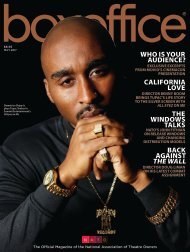Boxoffice - October 2016
The Official Magazine of the National Association of Theatre Owners
The Official Magazine of the National Association of Theatre Owners
Create successful ePaper yourself
Turn your PDF publications into a flip-book with our unique Google optimized e-Paper software.
NATO<br />
NEWS<br />
Alain Sussfeld<br />
co-CEO of UGC<br />
n Ideally situated on the Avenue<br />
Champs-Élysées in Paris, just west<br />
of the iconic Arc de Triomphe, sit<br />
the business offices for UGC, one<br />
of France’s leading exhibition and<br />
distribution companies. The view<br />
from the top floor, suffice to say,<br />
is remarkable. A glance from one<br />
office window reveals a mesmerizing<br />
panorama from the Eiffel Tower to<br />
the aforementioned arch at Place de<br />
l’Étoile. It’s old Paris in its imposing<br />
majesty. The view from the opposite<br />
office window faces La Défense, a<br />
modern business district full of glass<br />
high-rises and steel skyscrapers. It’s<br />
new Paris in its shimmering glory.<br />
This visual dichotomy epitomizes<br />
UGC’s focus on maintaining tradition while also<br />
looking toward the future. And that variety manifests<br />
itself at the multiplex.<br />
It only takes a casual glance at the show times<br />
in Paris to notice the array of options available for<br />
moviegoers in the French capital. With 206 million<br />
tickets sold in 2015, France is the largest moviegoing<br />
market in Europe in terms of admissions and a<br />
close second to the U.K.<br />
in terms of box office.<br />
UNLIMITED<br />
OPTIONS<br />
France's UGC helps pioneer<br />
a new program to strengthen<br />
the diversity of programming<br />
at the movies<br />
by David Binet, Director of Membership, NATO<br />
What makes this moviegoing<br />
figure intriguing<br />
is that it is nearly 80<br />
percent higher than it<br />
was 25 years ago, when<br />
France bottomed out<br />
by hitting a historically<br />
low level of admissions.<br />
The market’s rebound<br />
has been achieved, in<br />
part, by collaboration<br />
among the film industry’s segments in establishing<br />
admissions-driving policies. Another such example<br />
occurred this May, when trade bodies representing<br />
production, distribution, and exhibition signed<br />
an agreement with production and distribution<br />
companies to help strengthen the market by putting<br />
in place best practices to support wider diversity in<br />
programming.<br />
For Alain Sussfeld, co-CEO of UGC, the right<br />
mix to optimize moviegoing in France should ideally<br />
be 50 percent of the box office coming from U.S.<br />
movies, 40 percent from French movies, and the<br />
remaining 10 percent from other European and<br />
non-European productions. “This is hard to create,”<br />
Sussfeld said in an interview with <strong>Boxoffice</strong> Media<br />
CEO Julien Marcel. “Even harder to maintain, but<br />
this is essential to offer the type of quality and diversity<br />
our audience expects.”<br />
According to Sussfeld, one should not consider<br />
diversity to be a threat to the success of Hollywood or<br />
domestic blockbusters. All movies benefit from a good<br />
market. Rather than representing conflicting interests,<br />
Sussfeld calls it an “addition of interests.”<br />
“The goal of movie theaters should be to make sure<br />
that, at any point in time, all types of audiences can<br />
be offered a movie that matches their interests, tastes,<br />
or simply their mood of the day. Let’s not be obsessed<br />
with blockbusters targeting the teenagers. Let’s focus<br />
on the complete range of moviegoers from 5 to 75.”<br />
The agreement signed in May between the industry’s<br />
trade bodies suggests that UGC’s philosophy on<br />
diversity is shared by others in the industry. The two<br />
principal dimensions to the agreement that affect<br />
exhibition aim to optimize screen counts and show<br />
times for all films on the market. Firstly, all stakeholders<br />
agreed to limit the number of screens dedicated to<br />
any given film on any given day. The underlying idea<br />
is that it is not good to overexpose a movie in a short<br />
period of time. “Cinema cannot be summarized as<br />
‘Take the money and run,’” said Sussfeld. “A movie<br />
needs time in theater; it is part of its value. Putting<br />
a blockbuster in too many screens and then getting<br />
rid of it two weeks later is not good for anyone.”<br />
Additionally, exhibitors take a commitment to offer a<br />
predefined number of show times for limited-release<br />
movies that would otherwise have a hard time making<br />
it to the big screen. The strategy seeks to limit the<br />
overexposure of blockbusters and applies equally to<br />
French and U.S. movies.<br />
Behind this approach is the idea that a solid theatrical<br />
market requires a long-term strategy that includes<br />
diversity of content rather than the maximization of<br />
box office week after week. According to Sussfeld,<br />
there is no successful diversity strategy without a<br />
consistent commercial policy. In UGC’s case, this<br />
policy is based on a strong loyalty program and an<br />
unlimited subscription pass that aims to help viewers<br />
discover new films. UGC’s unlimited pass is particularly<br />
designed to reinforce the likelihood that moviegoers<br />
will try different types of movies and adopt an attitude<br />
of discovery in future cinema visits. As a result, UGC<br />
is able to retain its fair share of blockbuster admissions<br />
while over-performing on limited-release movies,<br />
helping them balance low-attendance periods.<br />
Sussfeld says his main concern is that this model<br />
hasn’t yet been adopted outside France, making<br />
it fragile by definition. With the support of other<br />
markets, Sussfeld believes there would be a better<br />
understanding of the specificities of moviegoing in<br />
each market. Leave it to the French to teach us a thing<br />
or two about maintaining a cultural commodity.<br />
Ultimately, however, the model’s long-term<br />
sustainability cannot exist without a solid slate of<br />
releases. Year-to-date admissions in France, up 4.1<br />
percent at the end of August, suggest the market<br />
hasn’t encountered any difficulty adopting this new<br />
model. The question for the near future now becomes,<br />
will any other markets venture to attempt something<br />
similar? n<br />
20 BoxOffice ® OCTOBER <strong>2016</strong>
















